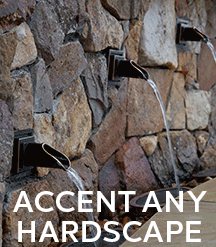Articles written by guest contributors

Are the "big leagues" (in SRWs) better?
By Brenda Bredahl, Versa-Lok® Retaining Wall SystemsEvery spring, college baseball players dream of the big leagues. Many hardscape contractors, too, wonder about moving into the big project market, imagining big profits building tall, expansive walls.
Matt Singer, Director of National Sales and Training for Versa-Lok® Retaining Wall Systems, discusses the ins and outs of the big project market with contractors around the country. He shares his insights below.
Matt Singer, Director of National Sales and Training for Versa-Lok® Retaining Wall Systems, discusses the ins and outs of the big project market with contractors around the country. He shares his insights below.

Matt Singer
Are big walls better?
Matt: Bigger does not always mean better. At spring training, our off-season training sessions, we always give what we call a "scared straight" talk, so that contractors take time to think about the many factors involved in taking a leap from smaller walls for homeowners and small businesses to big walls for large corporations or municipalities.What are some of the things contractors should consider?
Matt: Like any business, contractors need to consider their individual strengths and capabilities. I always tell sales people that you have to know a little about a lot. But I tell contractors it's good to know a lot about a little, whether it's outdoor kitchens, freestanding walls, patios, terraced walls, steps or seat walls. Specialize and create a niche that you can sell because that will help you differentiate your company from competitors.What are the differences in working with small vs. large project clients?
Matt: With big projects you are often the sub-of-a-subcontractor of the general contractor. This can affect many things, like access to the job site, chain of command, payments and more.It's easier to get decisions on changes when you are dealing with a homeowner or small business owner. If a tree needs to be removed, you can get an immediate decision. On a big commercial wall, the decision maker might be several steps away. You need to go to the first subcontractor, who has to go to the general contractor. The general might have to go to the developer, who then checks with the architect and/or engineer.
A decision can be days or weeks off. This costs you time and money in idle equipment and staff. It's also costly to remobilize equipment to another site while the decision is being made, and to bring it back after the decision is made. Most contractors don't have enough staff or equipment to have 2 or 3 projects going at the same time.
What about access and time constraints?
Matt: With a small job, weather is the biggest variable regarding access to the site. With a big job, you might be ready but the job site's not ready. There can be a penalty if the job is not done by a certain time, and weather is not typically factored into contracts.One contractor was on a project with 10 different walls. He finished 4, and then the rains came. He demobilized, went on to other projects and had to keep moving equipment and people back and forth. That cuts deeply into the profit margin.
What are the differences in estimating?
Matt: Small contractors might bid simple projects on square footage. With taller walls, you introduce grid, engineering and more complexity in general. So, you need a higher level of expertise.A large wall company will have a dedicated estimator who visits the site, reads the plans and knows exactly what they are getting into because they've worked with the general contractor before.
Payment differences?
Matt: With small projects getting paid is pretty straightforward: you send an invoice to the client, and they send you a check. On a big project, you are getting a draw according to your contract but there is typically a 10% retainage until the job is completed.Retaining walls are usually the first thing completed on a site, then the parking lot, building and building interior. You can wait 6 months or longer for the entire project to be completed to get the final 10%, which may be your profit margin.
What's needed to convert your company to build big walls?
Matt: You need bigger equipment with bigger walls. Sometimes contractors lease the equipment. But if something happens, like a rain delay, you are renting that equipment for those days and not getting paid.There's also the learning curve of experience, and the consideration of what you can do with the equipment and people you have, and the equipment and people you would need to move to the next level.
Essentially you could double expenses over a period of time to, let's say, get another 20% in profits. Can you handle 2 or 3 years of that to get into the big wall business? You also have to factor in hiccups, because everything doesn't always go smoothly. You have to expect the unexpected – that's about the only thing that is certain.
What other advice do you have for the aspiring big wall contractor?
Matt: Most big wall contractors have established relationships with general contractors from past jobs. Typically with those relationships, the general will give you a "last look" at your bid. This can provide the opportunity to see what you might have missed, what other contractors have missed and a last check of the specs.The upshot is to be good at what you do and you'll be successful. The big jobs look attractive, but beware of the risks. The grass isn't always greener...
















